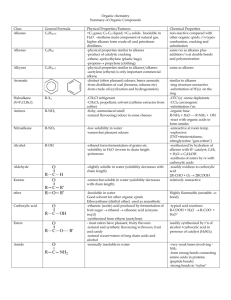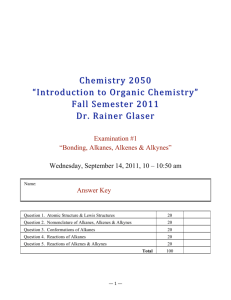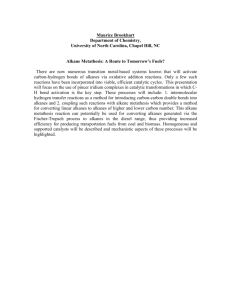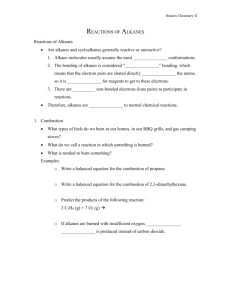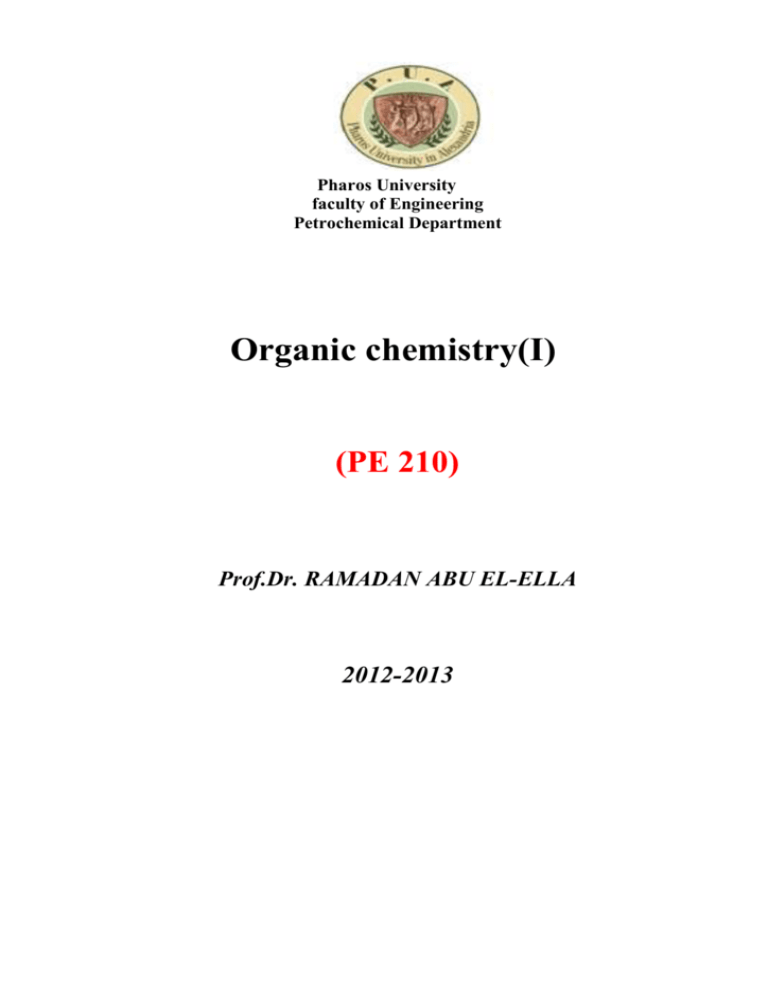
Pharos University
faculty of Engineering
Petrochemical Department
Organic chemistry(I)
(PE 210)
Prof.Dr. RAMADAN ABU EL-ELLA
2012-2013
Table of contents
I -Identification of organic compounds :
1- Introduction
2- Electron Configuration of carbon atom
3- Molecular and Structural formula
4- Hydrocarbons Classification
5- Saturated Hydrocarbons
6- Functional group
П- Alkanes and Alkyl group
1- Alkyl group
2- Naming branched-chain alkanes
3- Properties of alkanes
4- Preparation of alkanes
5-Cyclic alkanes:
a) Naming cyclic alkanes
b) Cis-Trans Isomerism in cyclo-alkanes
ш- Alkenes (Olefins):
1- Introduction
2- Nomenclature
a) Common Method
b) IUPAC
c) Geometric Isomers
3- Preparation of alkenes
4- Physical properties
5- Chemical properties
IV-Alkynes:
1- Introduction
2- Nomenclature
3- Preparation
4- Physical properties
5- Chemical properties
2
V-Alcohols:
1- Introduction
2- Classification
3- Nomenclature
4- Preparation
5- physical properties
6- chemical properties
VI-Aldehydes and Ketones:
1- Introduction
2- Nomenclature
3- Preparation
4- Physical properties
5- Chemical properties
VII-Carboxylic acids:
1- Introduction
2- Nomenclature
3- Preparation
4- Physical properties
5-Chemical properties
References:
1-Chemistry by Steven S.Zumdahl and Susana A. Zumdahal.Houghton Miffin,Boston,
Newyork.seventh Edition.
2-Organic Chemistry by paula Yurkains Bruic , Pearson Prentice Hall , Fourth Edittion.
3-Fundementals of Organic Chemistry by Mc Murry and Simanek, Sixth Edittion, Thomson,
Brooks/Cole.
3
COURSE ANALYSIS
Name: Organic Chemistry (1)
Contact hours:
lec. (2)
Code: PE 210
Lab (3)
(3Cr)
Tut. (0)
A)The theoretical part include the following:
Week
lecture
content
1
2
3
4
5
6
7
8
9
10
11
12
13
14
15
16
Lec.1
Lec.2
Lec.3
Lec.4
Lec.5
Lec.6
Lec.7
Lec.8
Identification of organic compounds
Alkanes and alkyl groups
Properties &preparation of alkanes
Cyclic alkanes
Alkenes
Properties &preparation of alkenes
Alkynes
Alkynes
MID TERM EXAM
Lec.9
Alcohols
Lec.10
Alcohols
Lec.11
Aldehydes &ketones
Lec.12
Carboxylic acids
Revision
LAB EXAM
FINAL EXAM
B)The tutorial /lab weekly include the following :
Week
Tut.
lab
Week 1
Week 2
Introduce the lab , Safety
Sheet(1)naming of HC
Identify the physical properties of
organic compounds
Week 3
Sheet(2)Naming of
Identify the alcohols(known)
alkanes
Week 4
Sheet (3) preparation of
Identify the alcohols(unknown)
alkanes
Week 5
Sheet (4) Naming of
Identify the alcohols(unknown)
alkenes
Week 6
Week 7
Sheet(5) preparation of
Identify the Aldehydes
alkenes
&ketones(known)
Sheet(6) Naming of
Identify the Aldehydes &ketones(unknown)
4
alkynes
Week 8
Sheet(7)alcohols
Identify the Aldehydes
&ketones(unknown)
Week 9
MID TERM EXAM
Week 10
Sheet(8)aldhydes&ketones Identify the carboxylic acids (known)
Week 11
Sheet(9)carboxylic acid
Identify the carboxylic acids
(unknown)
Week 12
Scheme of all pervious functional
groups
Week 13
Scheme of all pervious functional
groups
Week 14
Scheme of all pervious functional
groups
Lab exam
Week 15
C) Assessment:
* From week 1 to week 14 -------------------------20%(quizzes+ attendance+ Assignments)
* Mid term exam
------------------------20%
* Final lab exam -----------------------------------10%
*Final exam
-----------------------------------50%
D) Reference
Text book
Author
1- Fundamental of organic
chemistry,3rd edition,
By T.W Graham
Solomons,1994
2-Organic Chemistry, Fourth edition
By P.Y.Brnice,2004
E) Office hours
Monday
: 10:30-12:20
5
Publisher
ISBN
F) Aim of the course & intellectual skills:
Draw structural formulas for alkanes.
• Classify an organic compound based on its structural or condensed structural formula
• Draw a structural formula with the functional group(s) on a straight chain hydrocarbon
backbone, when given the correct IUPAC name for the compound.
• Find the parent hydrocarbon.
• Number the atoms in the main chain.
• Identify and number the substituents.
• Write the name of an alkane as a single word.
• Draw a structure from the IUPAC name of the alkane.
• Find the IUPAC name for a given structure of an alkane.
• Know how to prepare alkanes.
• Name cyclic alkanes.
• Draw Cis – Trans Isomers for different cycloalkanes.
• Draw Cycloalkane with any number of carbons.
• Convert skeletal structures in to molecular formulas.
• Propose structures for molecular formula
• Draw structural formulas for alkenes.
• Draw a structure from the IUPAC name of the alkene.
• Find the IUPAC name for a given structure of an alkene.
• Know how to prepare alkenes.
• Identify types of alkene reactions.
• Draw structural formulas for alkynes.
• Draw a structure from the IUPAC name of the alkyne.
• Find the IUPAC namefor a given structure of an alkyne.
• Know how to prepare alkynes.
• Identify types of alkyne reactions.
• Draw structural formulas for alcohols.
• Draw a structure from the IUPAC name of the alcohols.
• Find the IUPAC name for a given structure of an alcohol.
• Know how to prepare alcohols.
• Identify types of alcohol reactions.
• Draw structural formulas for Aldehydes and Ketones.
• Draw a structure from the IUPAC name of Aldehydes and Ketones.
• Find the IUPAC name for a given structure of Aldehydes and Ketones.
• Know how to prepare Aldehydes and Ketones
• Identify types of Aldehydes and Ketones.
reactions.
• Draw structural formulas for Carboxylic Acids
• Draw a structure from the IUPAC name of Carboxylic Acids
• Find the IUPAC name for a given structure of. Carboxylic Acids
• Know how to prepare Carboxylic Acids
• Identify types of Carboxylic Acids reactions.
6
І- Identification of Organic compounds
Lecture(1)
1-Introduction:
Carbon and silicon form the basis of most natural substances. Silicon with its great affinity
for oxygen, forms chains and rings containing Si—o—Si bridges to produce the silica and
silicates that form the basis for most rocks, sands and soils. On the other hand carbon has the
unusual ability of bonding strongly to itself to form long chain or rings of carbon atoms. In
addition, carbon forms strong bonds to other non –metals such as hydrogen, nitrogen, oxygen,
sulfur and other halogens, several millions of organic compounds are now known. The study of
carbon containing compounds and their properties is called “organic chemistry”.
2-Electron configuration of carbon atom:
The ground state electron configuration of an atom is a description of the orbital that the
atom’s electrons occupy. We can predict this arrangement for carbon atoms as follows:
1S
2S
2P
Since the atomic number of carbon is “6”. The carbon bonds to other atoms are called covalent
bonds and the carbon atom form single, double or triple bonds, carbon atoms form long chain,
branched chains and rings
3-Molecular and structural formula:
The actual number of each kind of atoms in a molecule is given by the molecular formula, while
the structure formula, indicates the geometric configuration.
Molecular formula
Methane
CH4
structure formula
H
H
C
H
7
H
Molecular formula
structure formula
H
Ethane
CH3CH3
H
C
H
Propane
Butane
Pentane
H
C
H
H
H
H
H
H
C
C
C
H
H
H
CH3CH2CH3
CH3CH2CH2CH3
CH3CH2CH2CH2CH3
8
H
4-Hydrocarbons:
Hydrocarbons are organic compounds which contain only carbon and hydrogen.
Classifications of hydrocarbons:
HYDROCARBONS
CONTAIN ONLY C, H
AROMATIC
HYDROCARBONS
CONTAIN BENZENE
RING
ALIPHATIC
HYDROCARBONS
SATURATED
HYDROCARBONS
CONTAIN ONLY C-C
AND C-H SINGLE
BONDS
UNSATURATED
HYDROCARBONS
CONTAIN ONLY ONE OR
MORE C=C OR TRIPLE
BOND
ALKANES (PARAFFINS)
CONTAIN NO
SATURATED RING
CnH2n+2
ALKENES (OLEFINS)
CONTAIN ONE OR
MORE DOUBLE BONDS
C=C
CnH2n
CYCLOALKANES
(CYCLOPARAFFINS)
ALICYCLIC
CONTAIN CHAIN
FORMS SATURATED
RING CnH2n
ALKYNES
(ACETYLENES)
CONTAIN ONE OR
MORE TRIPLE BONDS
CnH2n-2
CnH2n+2
9
5-Saturated hydrocarbons:
They are compounds in which each carbon atom is bonded to four
other atoms by single covalent bonds. The twenty normal saturated
hydrocarbons are shown in the following table.
Table-1 Some straight chain saturated hydrocarbons (Alkanes)
State at
Room
Temp.
Alkyl
Name
Radical
(R)
1
Molecular formula (IUPAC)
Parent
name
hydrocarbon
Cn H2n+2
CH4
Methane
Gas
CH3
Methyl
2
C2H6
Ethane
Gas
C2H5
Ethyl
3
4
C3H8
Gas
Gas
C3H7
Propyl
C4H10
Propane
Butane
C4H9
Butyl
5
C5H12
Pentane
Liquid
6
C6H14
Hexane
Liquid
C5H11 Pentyl
C6H13 Hexyl
7
8
C7H16
Liquid
C8H18
Heptane
Octane
9
C9H2O
Nonane
Liquid
10 C10H22
Decane
Liquid
11 C11H24
Undecane
Liquid
12 C12H26
Dodecane
Liquid
13 C13H28
14 C14H30
Tridecane
Liquid
Tetradecane
Liquid
15 C15H32
Pentadecane
Liquid
16 C16H34
Hexadecane
17 C17H36
18 C18H38
19 C19H40
20 C20H42
Liquid
Liquid
Heptadecane Solid
Octadecane Solid
Nonadecane
Solid
Eicosane
Solid
10
C7H15 Heptyl
C8H17 Octyl
C9H19 Nonyl
C1OH2 Decyl
1
C11H23 Undecyl
C12H25 Dodecyl
C13H27 Tridecyl
C14H29 tetra decyl
C15H31 pentadecyl
C16H33 Hexadecyl
C17H35 heptadecyl
C18H37 Octadecyl
C19H39 Nonadecyl
C20H41 Eicosyl
6-Functional group:
Special arrangement of atoms within an organic molecule that is
responsible for the same characteristic chemical behavior.
Family name
General formula
Functional group
Alcohol
ROH
-OH
Ether
ROR
-O-
Amine
RNH2
-NH2
Aldehyde
RCOH
-COH
Ketone
RCOR
-CO
Carboxylic acids
RCOOH
-COOH
Ester
RCOOR
-COO
Amide
RCONH2
-CONH2
11
II-Alkanes and alkyl groups:
Alkanes are often described as saturated hydrocarbons, hydrocarbons
because they contain carbon and hydrogen atoms, saturated because they
have only C—C and C—H single bonds.
They have the general formula CnH2n+2, where n is any integer.
Alkanes are also occasionally called aliphatic compounds.
Only one structure is possible for CH4(methane),C2H6(ethane) and
C3H8(propane).if large numbers of carbons and hydrogen more than one
kind of molecule can form.
For example two that the molecule with the formula C4H10 can form in a
row (n-butane) or they can branch (iso-butane)
n-butane
iso-butane (2-methyl propane)
Similarly, there are three ways in which C5H12 molecules can form and
so on for larger alkanes:
n-pentane
2-methyl butane
(iso-pentane)
12
2,2-dimethyl propane ( New-pentane)
Compounds like butane, whose carbons connected in a row are called
straight-chain alkanes or normal (n) alkanes, where as compounds with
branched carbon chains, such as iso-butane are called branched-chain
alkanes. Compounds which have the same formula but different
structures are called isomers.
13





